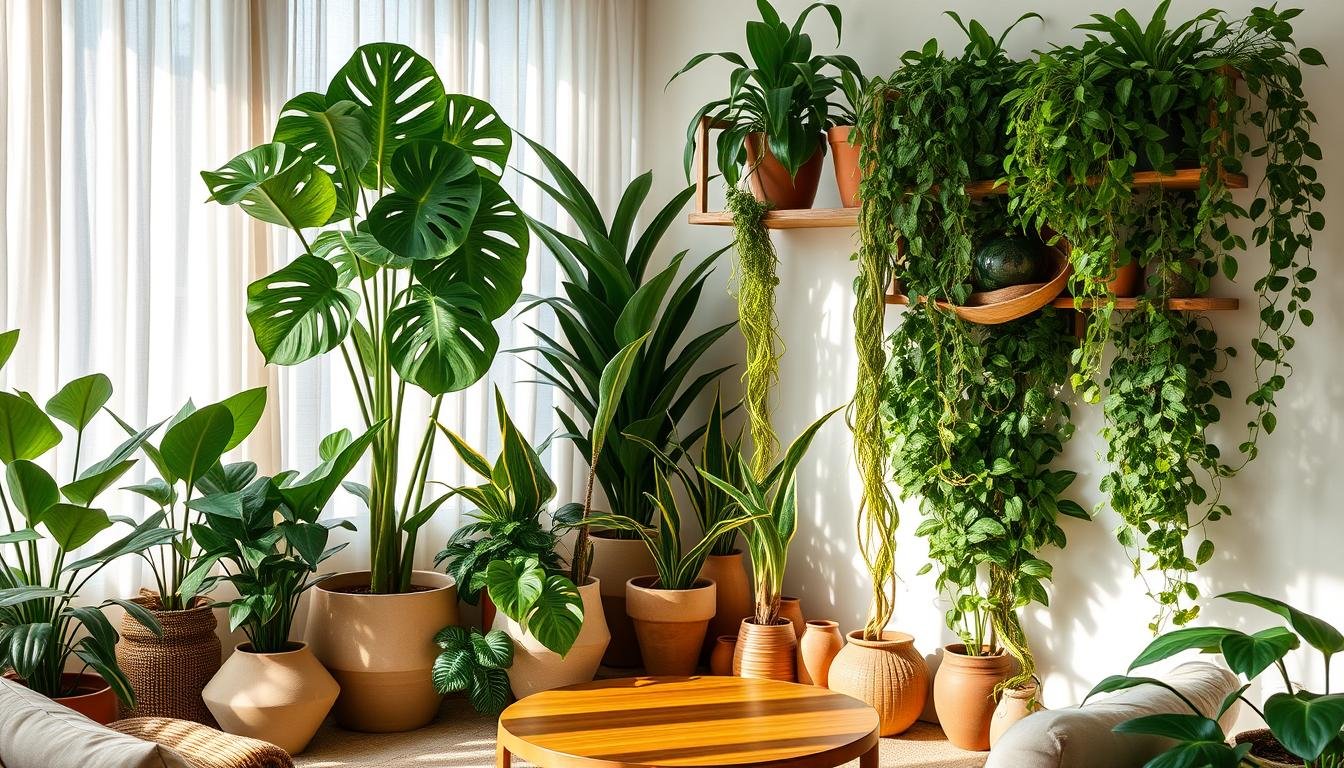Some links on this page are affiliate links. This means we may earn a commission at no additional cost to you if you click through and make a purchase. Thank you for your support!
Did you know Americans spend up to 90% of their time indoors? This fact shows how vital it is to have clean air in our homes. Luckily, nature offers a solution – indoor plants. They make our homes look great and also clean the air we breathe. Let’s dive into the world of these green wonders and see how they can make your space healthier and more stylish.
Key Takeaways
- Indoor plants are natural air filters, absorbing carbon dioxide and releasing oxygen while removing harmful pollutants.
- Certain plants, such as Bamboo Palm, Spider Plant, and Gerbera Daisy, are highly effective at removing formaldehyde, benzene, and other volatile organic compounds (VOCs) from indoor air.
- NASA’s Clean Air Study found that some plants can remove up to 87% of formaldehyde, benzene, and trichloroethylene from the air within 24 hours.
- Keeping at least 2-5 air-purifying plants per 100 square feet of indoor space can significantly improve air quality.
- Incorporating indoor plants into your home decor can not only enhance the air you breathe but also add a touch of natural beauty and style to your living spaces.
Understanding Indoor Air Quality and Pollution
Keeping our homes healthy starts with clean indoor air. Indoor air can hold many pollutants, like dust and chemicals from household items. These can harm our health, causing headaches and breathing problems.
Common Indoor Air Pollutants
Indoor air pollutants fall into two main categories: particulates and VOCs. Particulates include dust and mold spores. VOCs are chemicals from paints and cleaners. These can build up indoors, especially in poorly ventilated spaces.
The Impact of Poor Air Quality on Health
Poor indoor air can lead to headaches and breathing issues. It can also worsen existing health problems. Ignoring indoor air quality can harm our health over time.
Why Indoor Air Can Be More Polluted Than Outdoor Air
Indoor air is often more polluted than outdoor air. This is because homes lack natural ventilation. Synthetic materials also release harmful chemicals, making indoor air worse.
Improving indoor air quality is key to a healthy home. Adding air-purifying plants is a natural way to clean the air. It helps reduce the harm from pollutants.
How Plants Purify Indoor Air Through Natural Processes
Plants are nature’s own air purifiers! They absorb carbon dioxide and release oxygen through photosynthesis. This improves the quality of indoor air. Plants can also remove harmful pollutants like VOCs, formaldehyde, and particulate matter.
The leaves and roots of plants break down these chemicals. They convert them into useful nutrients. While the exact number of plants needed is debated, every plant helps. Plus, indoor plants add a fresh, earthy smell.
Some plants, like the snake plant, are great at absorbing carbon dioxide and releasing oxygen. They do this even at night. New bioengineered plants are being researched for even better air-cleaning abilities.
But, plants have limits compared to mechanical air purifiers. A large number of plants or an indoor “forest” is needed to significantly reduce VOCs. This makes it impractical for many homes.
Despite these limits, plants are still a popular choice for improving indoor air quality. They work well with other air-cleaning methods. This creates a healthier, more vibrant living space.
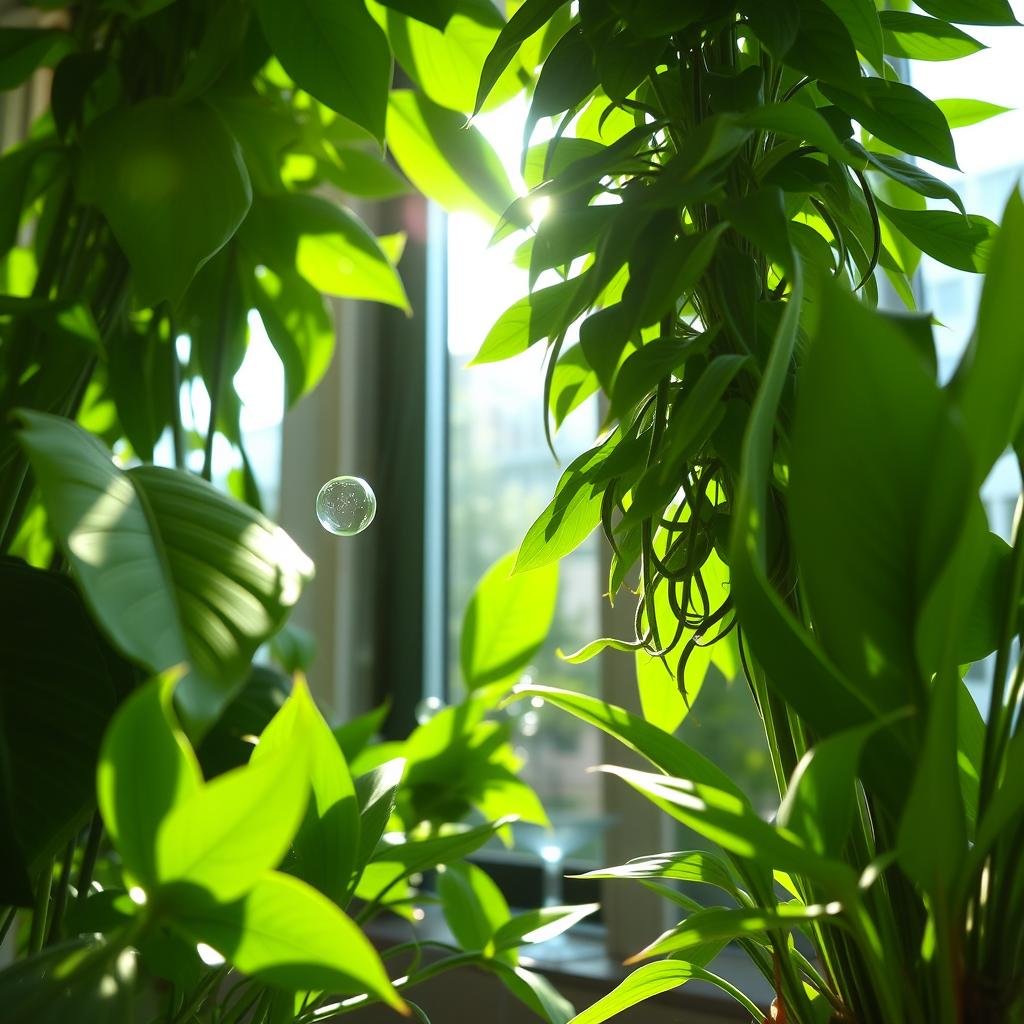
“Plants are nature’s own air purifiers, absorbing carbon dioxide and releasing oxygen through the process of photosynthesis.”
| Air Purification Technique | Effectiveness | Drawbacks |
|---|---|---|
| Mechanical Air Purifiers with HEPA Filters | Highly effective in removing airborne pollutants | Higher initial costs and energy consumption |
| Indoor Plants | Can remove VOCs and improve air quality to a certain extent | Large numbers required for significant VOC reduction, potential for mold growth and pest introduction |
| Active Green Walls | More efficient air filtration by concentrating plants and enhancing airflow | Costlier to install and maintain compared to individual plants |
The NASA Clean Air Study: Scientific Evidence
In 1989, the NASA Clean Air Study found that some indoor plants can clean up to 87% of air pollutants in just 24 hours. This research has shown us how nature can help purify the air we breathe.
Key Findings and Plant Effectiveness
The NASA study looked at 19 plant species, like Bamboo palm and Peace lily. These plants were able to remove harmful chemicals from the air.
Later studies have shown that the roots and soil of plants are key in cleaning the air. They do this through natural processes.
Recommended Number of Plants per Square Foot
Recent research says we might need 100-1,000 plants for every 10 square feet to really improve air quality. But don’t worry, even a few plants can help!
Research Limitations and Real-World Applications
The NASA study was done in a lab. Real-world results can vary due to things like room size and plant health. Yet, a 2008 study in India showed that plants can reduce headaches and respiratory problems.
In short, plants do purify the air, and while you might not need 200 plants, every bit helps make your home fresher and healthier!
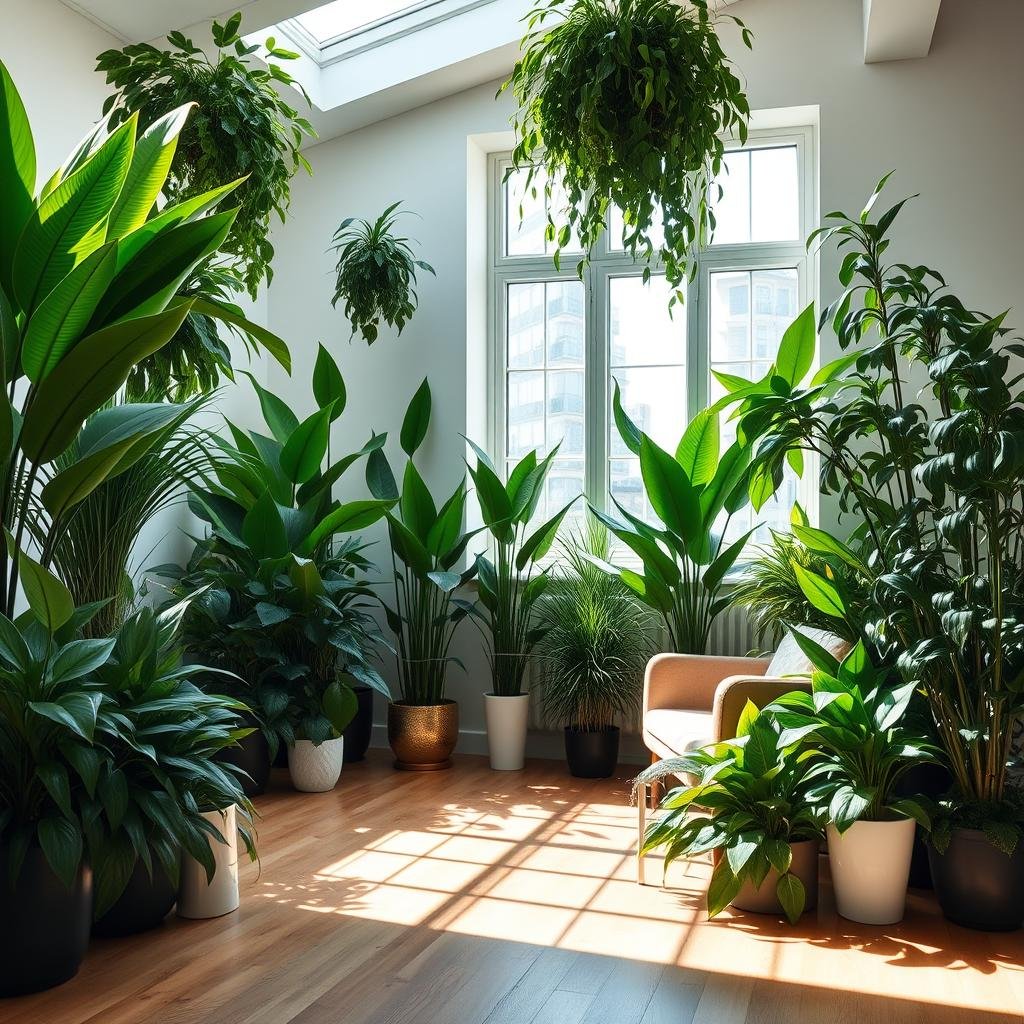
“The roots and soil of plants are the primary filters of pollutants, according to the NASA Clean Air Study.”
Indoor Plants for Cleaner Air: Top Performers
Discover the top air-purifying plants for your home! Some houseplants are better at cleaning indoor air than others. Let’s look at the best indoor plants that remove harmful toxins and pollutants.
The Spider Plant (Chlorophytum comosum) is a top choice. It removes formaldehyde, xylene, and toluene easily. The Snake Plant (Sansevieria trifasciata) is also great, tackling formaldehyde, benzene, xylene, toluene, and nitrogen oxides.
The Peace Lily (Spathiphyllum) is a standout. It cleans the air of formaldehyde, benzene, trichloroethylene, xylene, and ammonia. Aloe Vera (Aloe barbadensis miller) and Boston Fern (Nephrolepis exaltata) are also top picks, removing formaldehyde and benzene.
Other top plants include English Ivy (Hedera helix), Rubber Plant (Ficus elastica), Golden Pothos (Epipremnum aureum), Bamboo Palm (Chamaedorea seifrizii), Dracaena (Dracaena spp.), and Areca Palm (Dypsis lutescens). Each has its own air-purifying strengths, making them great for any indoor space.
By adding these air-cleaning plants to your home or office, you can make it healthier and more vibrant. Let’s welcome these natural wonders and enjoy cleaner, fresher air!
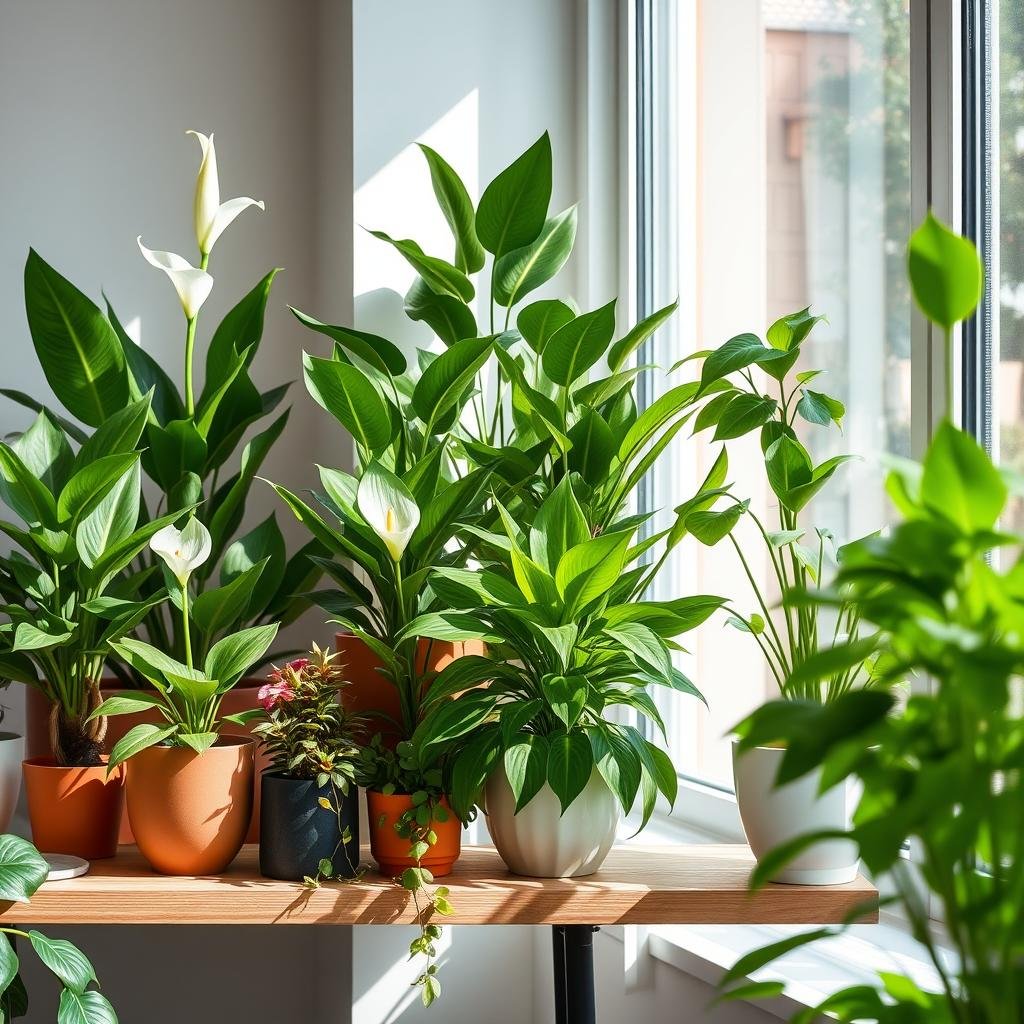
“Indoor air is typically 2-5 times more polluted than outdoor air, according to Environmental Protection Agency (EPA) research.”
Pet-Friendly Air Purifying Plants
Creating a healthy, clean-air home is key, especially when pets are involved. Luckily, many air-purifying plants are safe for pets. These pet-friendly houseplants not only clean the air but also beautify your home.
Safe Options for Homes with Cats and Dogs
Spider Plants, Boston Ferns, and Areca Palms are great for pet owners. They purify the air without harming pets. Gerbera Daisies and Bamboo Palms also brighten up any room.
Plants to Avoid if You Have Pets
Some plants, like Peace Lilies, Snake Plants, and English Ivy, are toxic to pets. These plants can be dangerous if pets eat them. Always check a plant’s safety before bringing it home.
Choosing the right pet-friendly air purifying plants makes your home safe and beautiful. With some research, you can find plants that clean the air and enhance your home’s style.
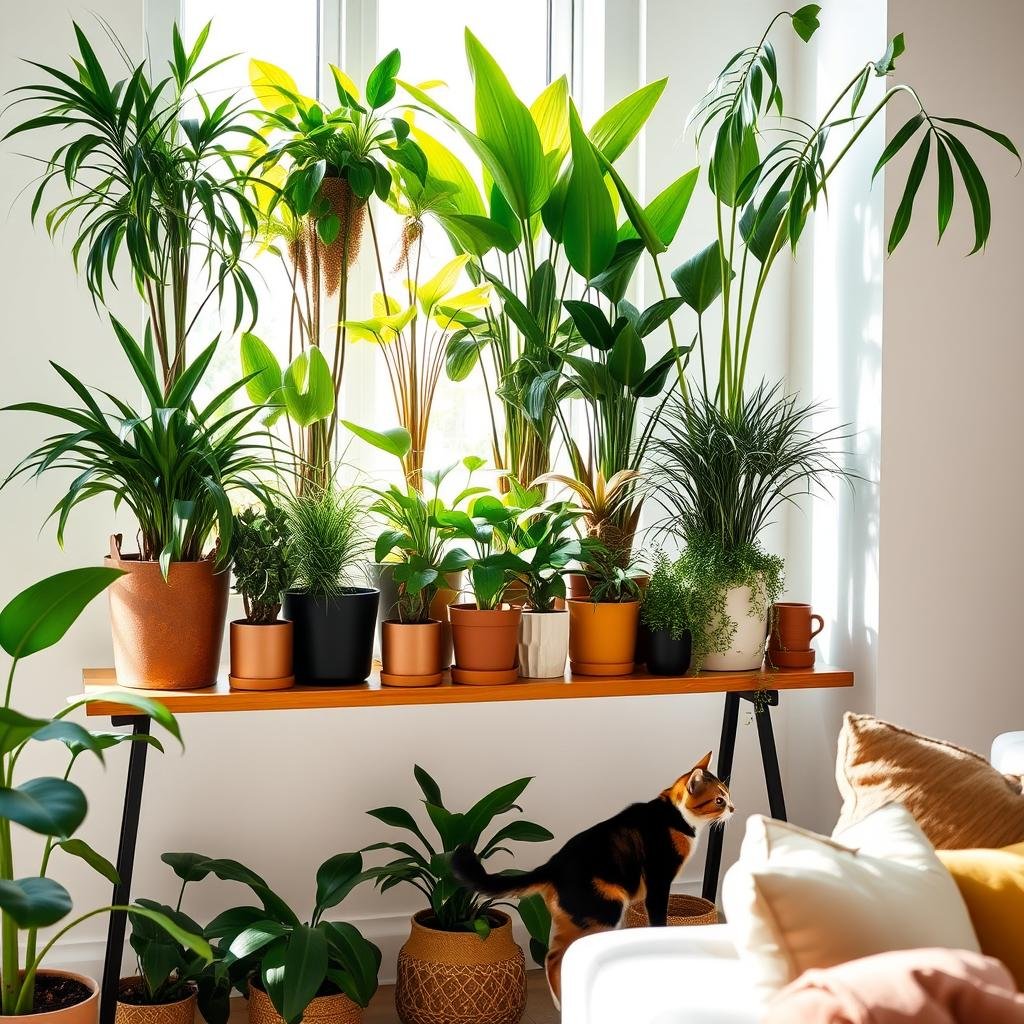
| Non-Toxic Plants | Toxic Plants |
|---|---|
|
|
Low-Light Air Purifying Plants for Dark Spaces
Don’t let a lack of sunlight stop you from purifying your indoor air! There are many low-light houseplants that can thrive in dark corners. These plants not only clean the air but also add natural beauty to your home.
The Snake Plant (Sansevieria) is great for low-light spots. It releases oxygen at night, perfect for bedrooms. Peace Lilies (Spathiphyllum) and Chinese Evergreens (Aglaonema) also thrive in shade. They remove toxins like alcohols, acetone, and formaldehyde.
For very dark rooms, try the Dracaena ‘Janet Craig’. It’s good at removing trichloroethylene, a common pollutant. The Weeping Fig (Ficus Benjamina) is also a good choice. It filters out benzene and formaldehyde well.
- Rubber Plant (Ficus elastica) for formaldehyde removal
- Pothos (Epipremnum aureum) for overall indoor toxin absorption
- Bamboo Palm (Dypsis lutescens) for benzene and formaldehyde filtering
- Boston Fern (Nephrolepis exaltata) for xylene, toluene, and benzene purification
- Variegated Spider Plant Reverse (Chlorophytum comosum) for air-cleaning and pet-friendliness
These plants show that even dark corners can be green and air-cleaning. With the right care, you can make any room healthier and more oxygen-rich, even if it’s very dark.
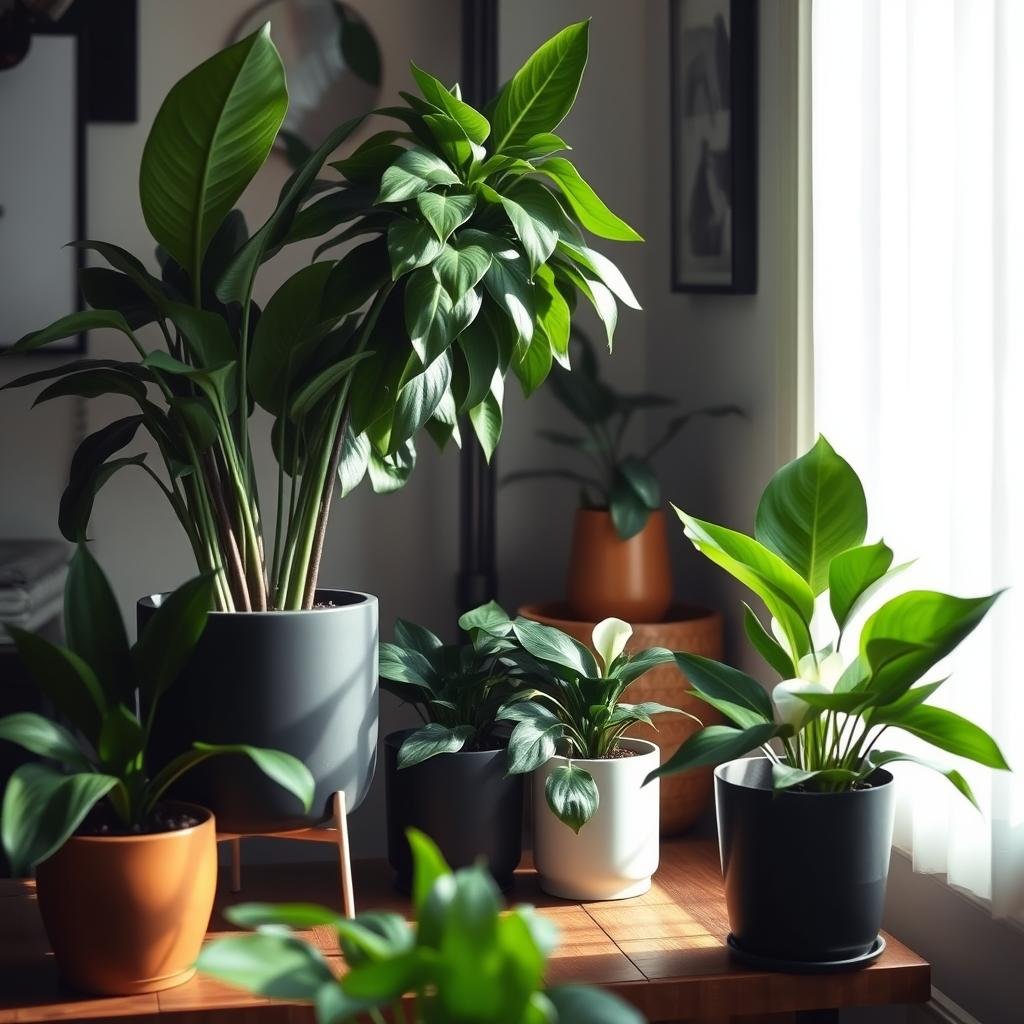
“Even the darkest corners of your home can benefit from some green, air-cleaning magic!”
Maintenance Tips for Healthy Air-Purifying Plants
To keep your air-purifying plants healthy, they need regular care. Most plants like moist soil, so water them when the top inch feels dry. For plants that love humidity, like Peace Lilies and Bromeliads, mist them often. Also, dust their leaves to help them grow well.
Watering and Humidity Requirements
- Water plants when the top inch of soil is dry, avoiding overwatering
- Humidity-loving plants like Peace Lilies and Bromeliads need regular misting
- Monitor soil moisture levels and adjust watering as needed for each plant
Cleaning and Pruning Guidelines
Keeping your plants clean and pruned is key for their health. Dust their leaves often to help them breathe. Prune dead or damaged parts to encourage new growth and keep them looking neat.
- Dust leaves regularly with a soft cloth to keep them clean
- Prune off dead or damaged leaves and flowers to promote healthy growth
- Remove any pests or signs of disease to ensure plants remain thriving
Happy, healthy plants purify the air better! By following these easy tips, your indoor plants will stay in top shape. They’ll keep your home air fresh and clean.
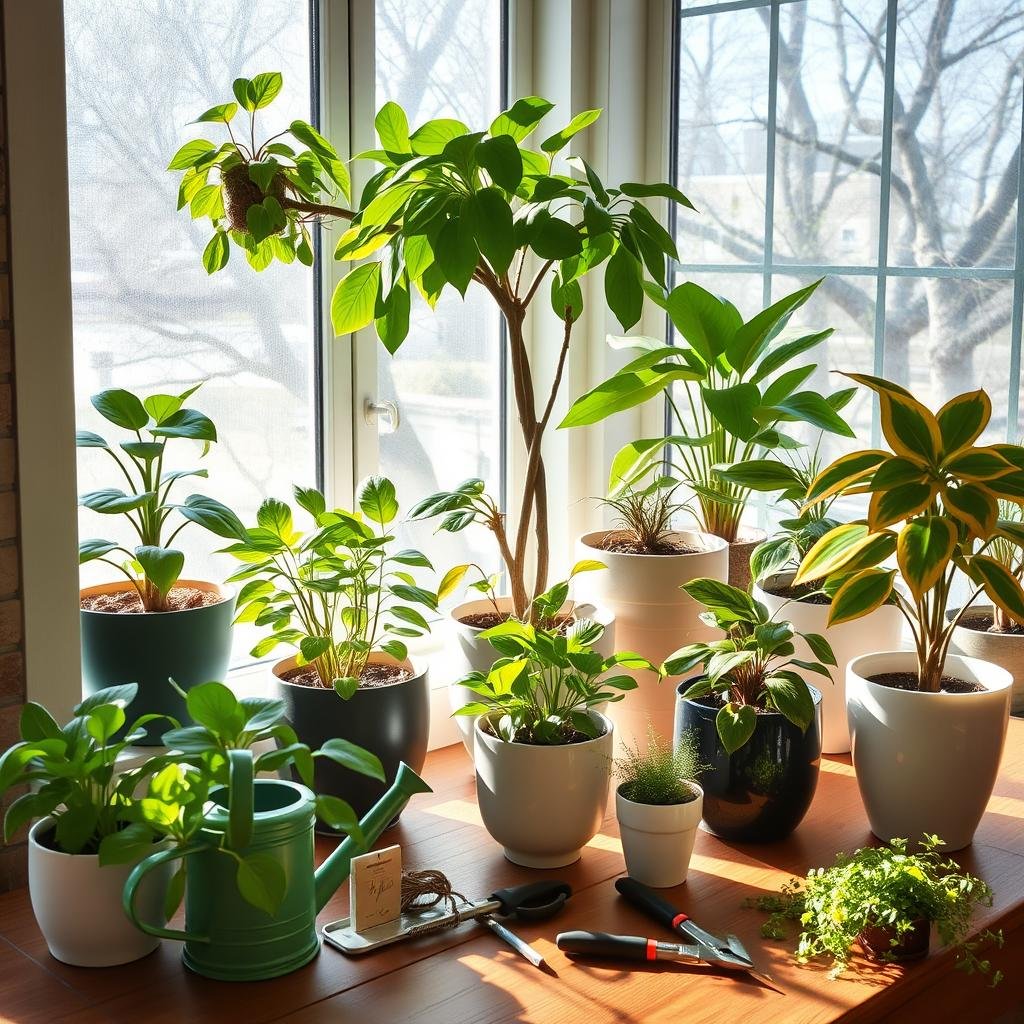
“Healthy plants are more efficient at purifying air than struggling ones. Regular maintenance like proper lighting, watering, fertilizing, repotting, and pest control are crucial for ensuring plants function well in air purification.”
Stylish Ways to Display Air-Purifying Plants
Make your home look great and breathe easier with stylish plant displays. Air-purifying plants can turn your space into a lush oasis. You can create anything from bold statements to flowing green walls.
Stand out with a big Rubber Plant or Bird of Paradise. They grab attention in any room. Hang Spider Plants or English Ivy to add fun and cover up walls. Mix plants of different sizes for a lush, welcoming feel.
Use wall-mounted planters to make the most of your space, especially in small homes. Choose pots that match your style to highlight your plants as part of your decor.
With a bit of creativity, your home can become a beautiful, natural oasis. Improve your indoor plant decor and enjoy cleaner air!
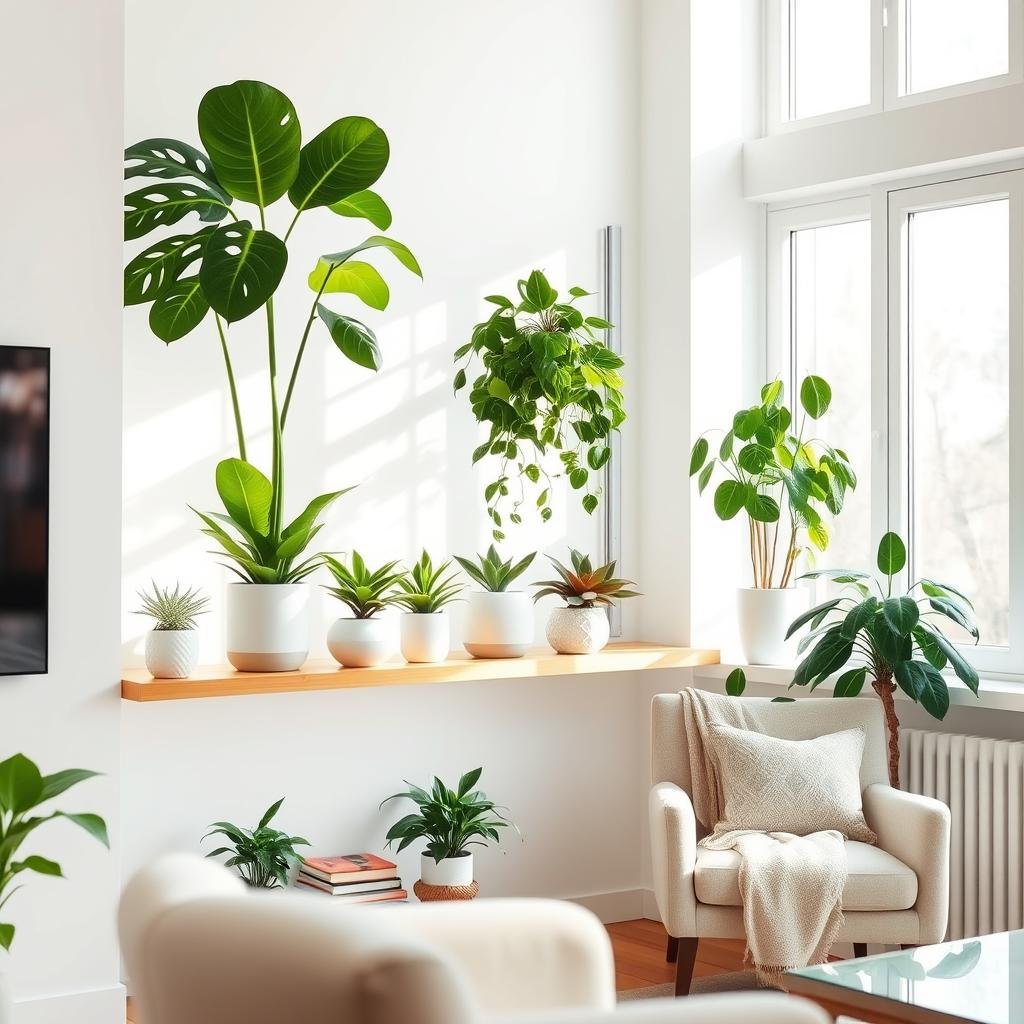
Innovative Display Ideas for Air-Purifying Plants
- Driftwood displays for a natural, organic look
- Hanging glass terrariums for a floating garden effect
- Air plant frames to create living wall art
- Ceramic or concrete holders for modern elegance
- Air plant chandeliers as impressive focal points
- Cork bark mounts for a rustic, earthy vibe
- Air plant wreaths for versatile indoor and outdoor use
- Kokedama for a unique, suspended plant display
- Suspended branches for a whimsical, forest-inspired feel
- Geometric metal structures for a minimalist, contemporary look
- Magnetic displays to showcase plants in unexpected places
- Terrariums for small-scale, self-contained ecosystems
- Seashell displays for a coastal-inspired, natural appeal
Enhance your plant decor and green home design. Discover exciting ways to display your air-purifying plant styling tips. Your home will flourish with beauty and clean air from these stunning displays.
Combining Plants with Modern Air Purifiers
To get the best air cleaning, mix the natural power of houseplants with modern air purifiers. HEPA filters are great at catching solid particles. But plants are experts at removing harmful gases and making air fresh and full of oxygen.
Creating an Effective Air-Cleaning System
For a strong air-cleaning team, put big plants like Areca Palms in room corners. Use smaller plants on desks and shelves near where you live and work. Think about how air moves in your space when placing plants and purifiers for the best results.
Optimal Plant Placement Strategies
- Put taller, bushier plants in corners to use their air-purifying power fully.
- Place smaller plants on desks, shelves, and tables near where you spend most of your time.
- Position plants to work with your HVAC system’s airflow for the best coverage.
- Change the layout of plants now and then to keep air moving and pollutants away.
By combining air-purifying plants with modern filters, you get the cleanest air in your home or office. Let nature and technology team up for the best indoor air quality!
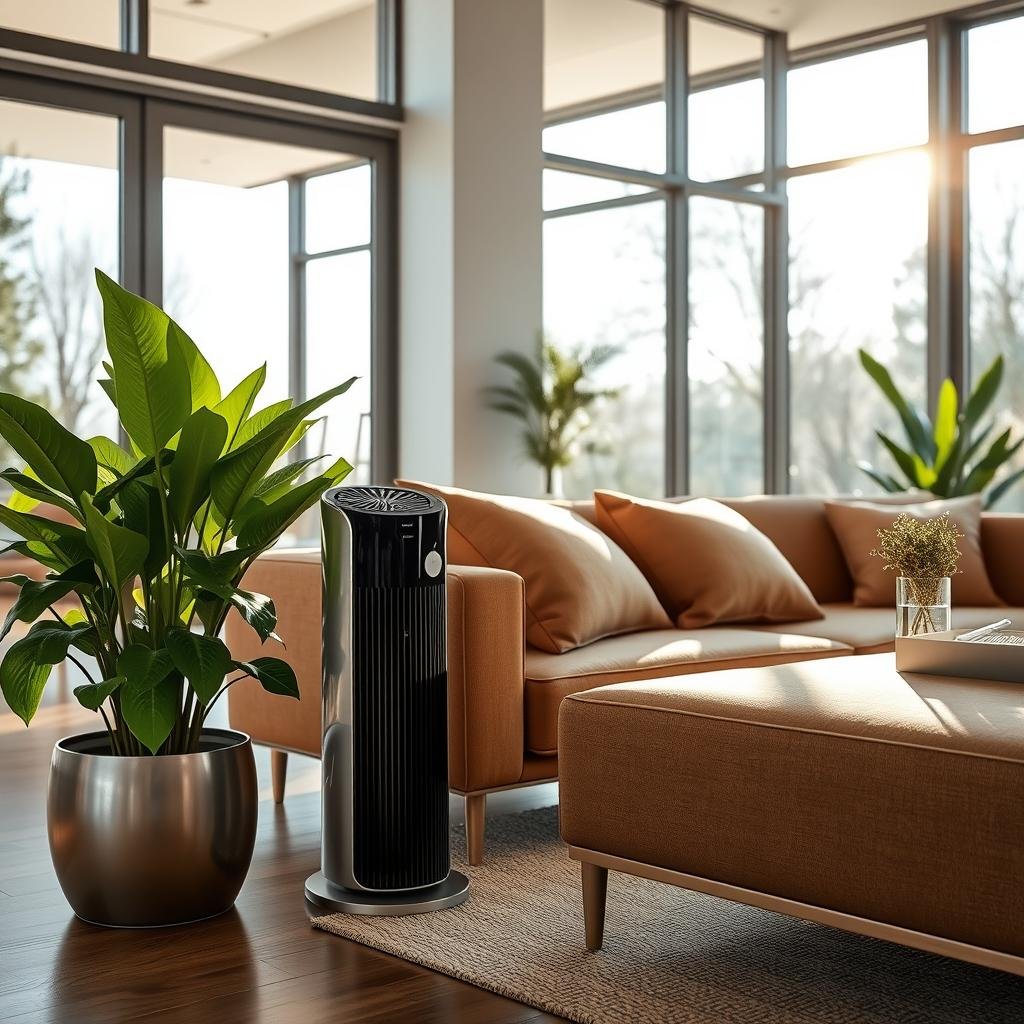
“Utilizing higher plants and their associated soil microorganisms can effectively tackle trace contamination issues and reduce indoor air pollutants.”
– NASA Research Study
Benefits Beyond Air Purification
Indoor plants do more than just clean the air. They boost your wellbeing in many ways. Plants increase humidity, which helps with dry skin and breathing issues. They also lower stress, improve mood, and boost productivity.
Some plants, like Aloe Vera, are super useful. You can use a leaf to treat minor burns or cuts. Caring for plants is calming and promotes relaxation. Adding green to your home is great for air and your health!
| Health Benefit | Relevant Plants |
|---|---|
| Increased Humidity | Spider Plant, Boston Fern, Philodendron |
| Stress Reduction | Lavender, Jasmine, Peace Lily |
| Improved Productivity | Snake Plant, Dracaena, Sansevieria |
| Practical Uses | Aloe Vera, Eucalyptus, Peppermint |
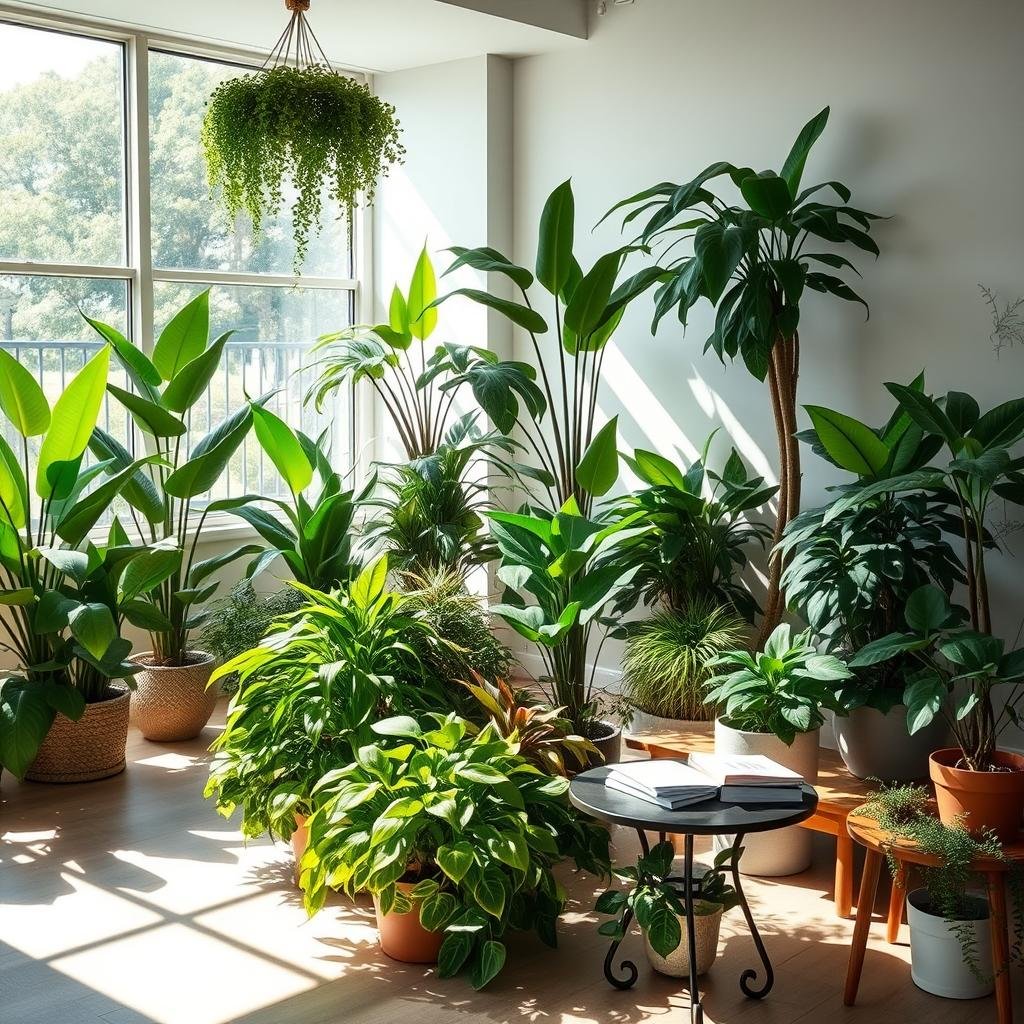
Indoor plants offer more than clean air. They help with humidity, stress, and mood. Adding the right plants to your home makes it greener and healthier.
Plants for Specific Indoor Pollutants
Creating a healthy indoor space means using plants that fight specific air pollutants. By picking plants for their air-purifying skills, you can tackle your home’s unique air challenges.
Spider Plants and Chrysanthemums are great at removing formaldehyde. This chemical is found in furniture, carpets, and cleaning products. For benzene, a chemical in cigarette smoke, English Ivy and Gerbera Daisies are good choices.
Peace Lilies are known for filtering out trichloroethylene, used in spot removers. Rubber Plants tackle carbon monoxide well. The Areca Palm is good for removing VOCs.
| Indoor Pollutant | Best Air-Purifying Plants |
|---|---|
| Formaldehyde | Spider Plant, Chrysanthemum |
| Benzene | English Ivy, Gerbera Daisy |
| Trichloroethylene | Peace Lily |
| Carbon Monoxide | Rubber Plant |
| Volatile Organic Compounds (VOCs) | Areca Palm |
By adding these plants to your home, you can make a targeted air purification system. This approach, with modern air purifiers, helps keep your home healthy and fresh.
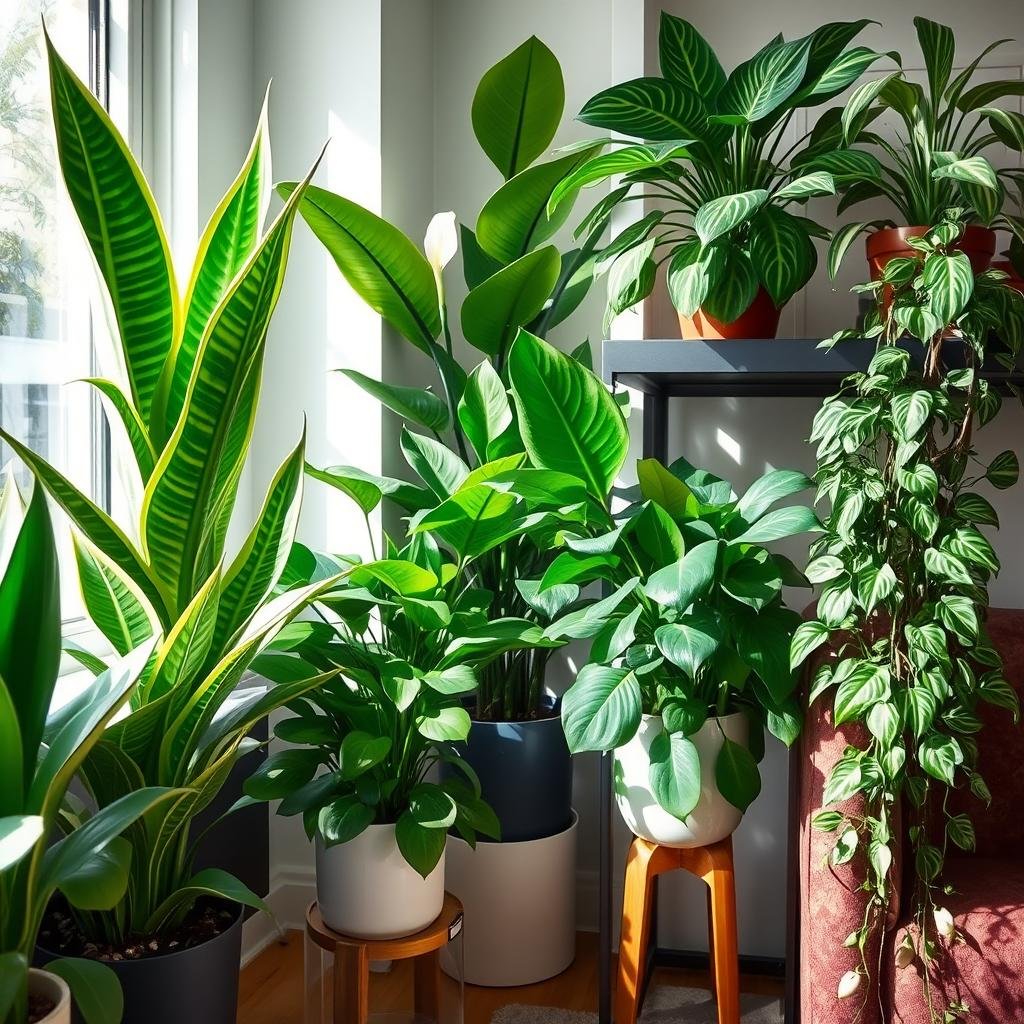
“Living plants are efficient at absorbing contaminants, with some being considered for future space missions to help maintain air quality within orbiting space stations.”
With the right targeted air purification plan, your home can become a clean, fresh air haven. This improves your well-being and living experience.
ALSO READ: Spring Outdoor Decor Ideas to Refresh Your Space
Conclusion
We’ve looked into how indoor air quality improvement and natural air purification work with air-purifying plants. We’ve seen how NASA-approved plants and stylish displays can make your home healthier and more lively.
Even a few plants can make a big difference in your home’s air. Every green living tip you use helps make your indoor air cleaner. Pick plants that fit your life and air quality needs. With the right plants, care, and placement, you’ll breathe easier and live greener.
Let’s use nature’s air purifiers to make our homes beautiful and healthy. We can create a space that’s not just pretty but also improves our air quality. Together, we can make our homes better for our health and the planet.
Frequently Asked Questions
What are the benefits of having indoor plants for air purification?
Indoor plants act as natural air filters. They absorb carbon dioxide and release oxygen. They also remove harmful pollutants like VOCs, formaldehyde, and particulate matter. This improves indoor air quality and makes your living space healthier.
How effective are indoor plants at purifying the air?
The NASA Clean Air Study found that some plants can remove up to 87% of air toxins in 24 hours. But newer studies say you need 100-1000 plants per 10 square feet for best results. Still, even a few plants can make a big difference in your home.
Which indoor plants are the best for air purification?
Top air-purifying plants include Spider Plants, Philodendrons, English Ivy, and Peace Lilies. Snake Plants, Bromeliads, Dracaenas, Weeping Figs, Rubber Plants, and Areca Palms are also great. These plants are good at removing pollutants like formaldehyde and benzene.
Are there pet-friendly air-purifying plants?
Yes, there are pet-friendly air-purifying plants like Spider Plants, Boston Ferns, and Areca Palms. But be careful with plants like Peace Lilies, Snake Plants, and English Ivy. They can be toxic to curious pets.
Can indoor plants thrive in low-light conditions?
Yes, they can! Snake Plants, Peace Lilies, Chinese Evergreens, and some Dracaena varieties do well in low light. They’re perfect for purifying the air in darker spaces.
How do I care for my air-purifying plants to keep them thriving?
Proper care is essential for healthy plants. Water them when the top inch of soil is dry. Mist plants that love humidity, dust their leaves, and prune dead foliage. With the right care, your plants will clean the air better.
How can I incorporate air-purifying plants into my home decor?
Be creative with your plants! Use big plants like Rubber Trees or Birds of Paradise as highlights. Hang plants like Spider Plants or English Ivy. Group plants of different heights for a lush look. Don’t forget to use wall-mounted planters for vertical space.
Can I combine indoor plants with modern air purifiers for better results?
Yes, you can! Plants and air purifiers work well together. Plants tackle VOCs and release oxygen, while air purifiers remove solid particles. Place big plants in corners and small ones near work areas. This combo creates a powerful air-cleaning system.

